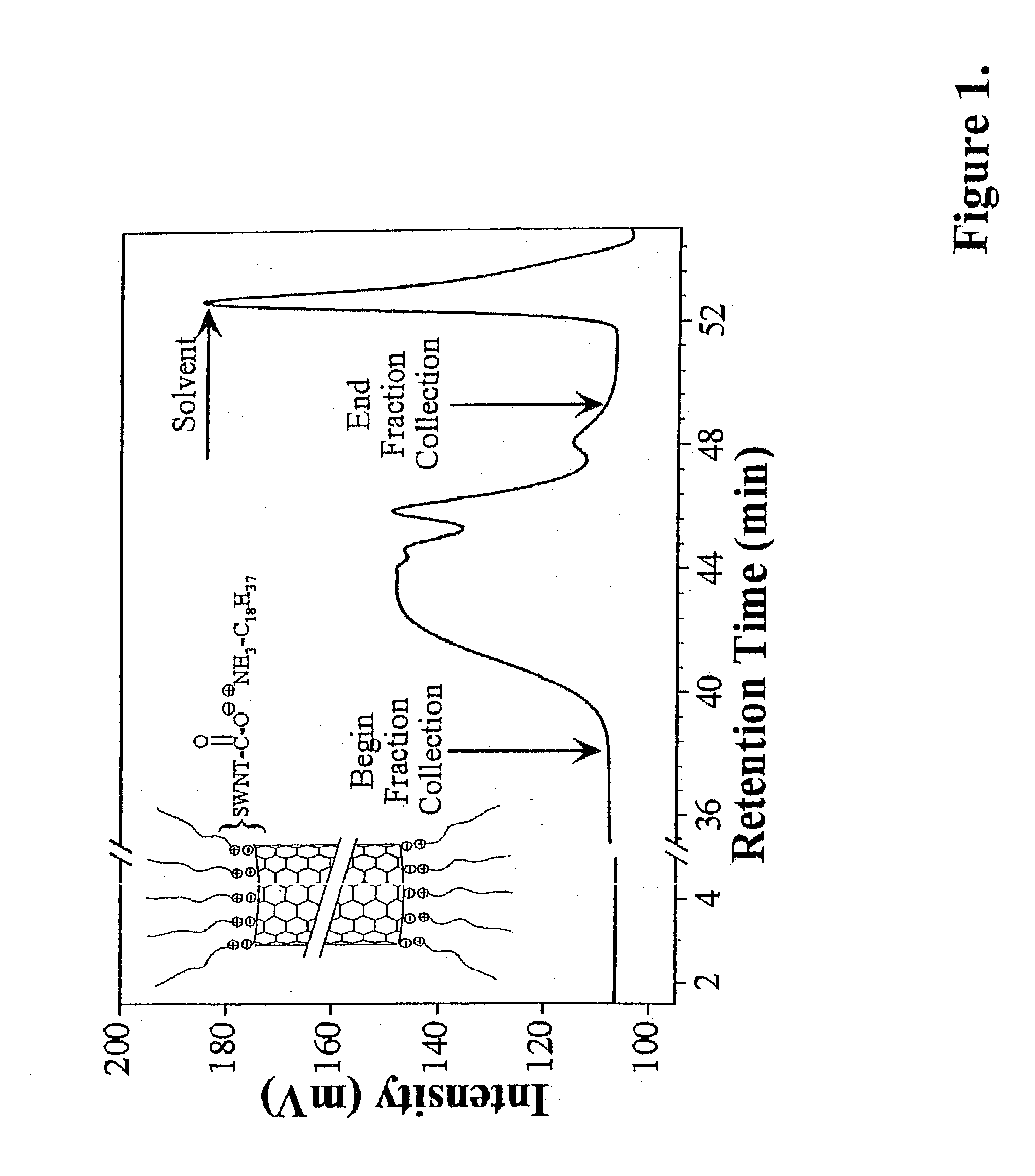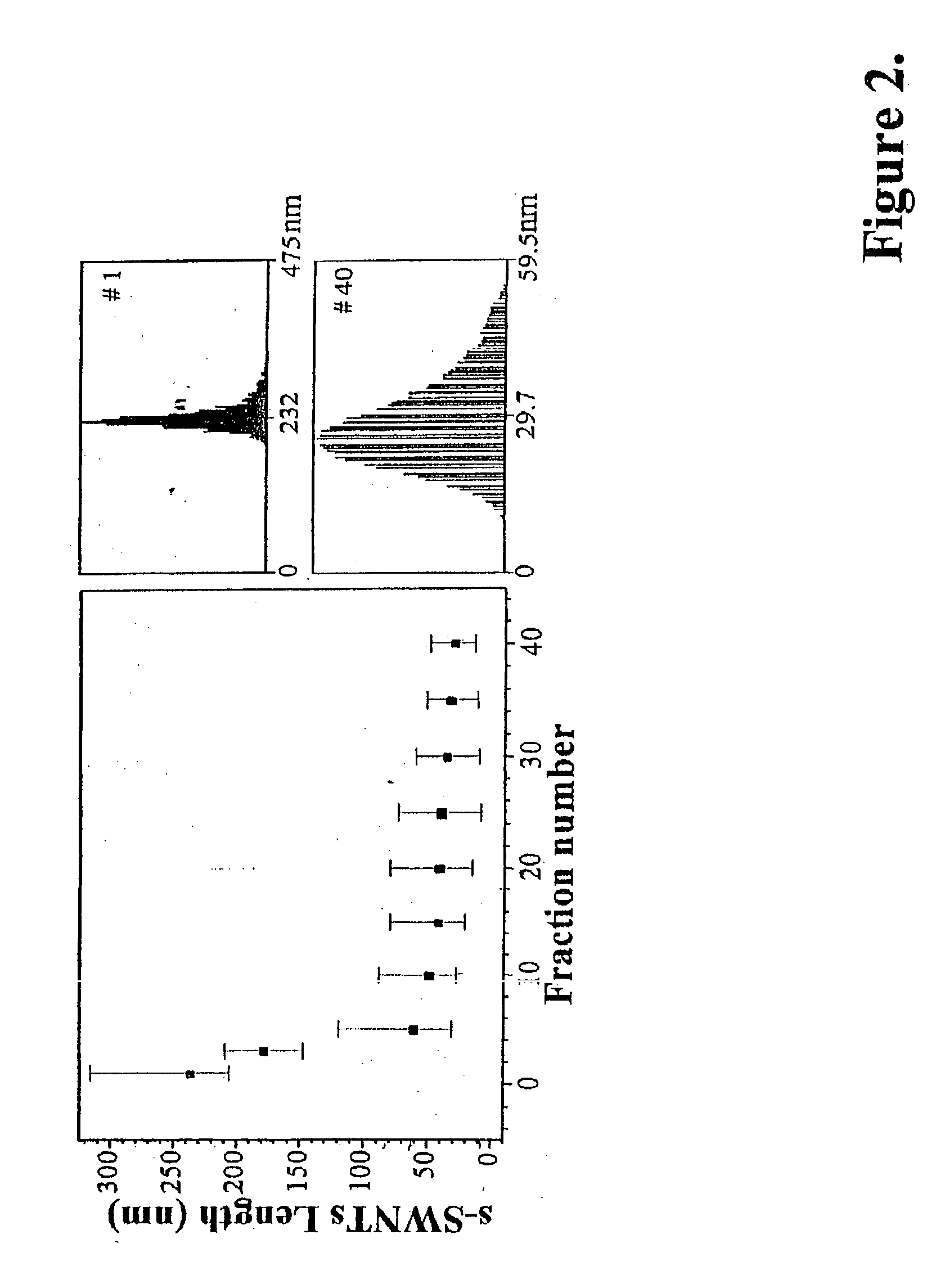Separation of single wall carbon nanotubes
a carbon nanotube and single-walled technology, applied in the field of carbon nanotube size and or type separation, can solve the problems of lithographic patterning cost, size limitations associated with traditional materials, and difficulty in separation of swnts post-synthesis, etc., and achieve the effect of improving size fractionation and solubility
- Summary
- Abstract
- Description
- Claims
- Application Information
AI Technical Summary
Benefits of technology
Problems solved by technology
Method used
Image
Examples
example 2
Characterization of Eluting Fractions
[0032] Dissolution of ODA-functionalized SWNTs in THF has been demonstrated, where the majority of the bundles were exfoliated in small ropes (2-5 nm in diameter) and a limited amount of individual nanotubes (Chen et al., J Phys Chem B 105, 2525, 2001). Assuming the dissolution is a result of the repulsive interaction induced by the ionically attached ODA end-groups, in the case of shortened-SWNTs, the flow-induced shearing through the GPC columns could further reduce aggregation and lead to length fractionation. The UV-Vis spectrum of a typical eluting fraction of sSWNTs in THF is presented in FIG. 3. This spectrum markedly contrasts that of the injected suspension (FIG. 3 inset), which was obtained after extensive sonication in THF and filtration through a 10 .mu.m Teflon.TM. filter. The profound difference in these two spectra might originate from either the complete exfoliation of the 2-5 nm diameter SWNTs ropes, or from the fractionation by ...
example 3
Enrichment for Metallic or Semiconducting SWNTs
[0035] The significant strain energy associated with small diameter and structural instability associated with varying helicity of SWNTs have also allowed us to preferentially enrich different fractions with either metallic or semiconducting nanotubes during the oxidative shortening of SWNTs a mixture (7:3) of HNO.sub.3 and H.sub.2SO.sub.4. FIG. 6 illustrates the NIR spectra of various elution fractions as collected from the GPC column (i.e. with no further solvent (THF) dilution or concentration). The pronounced increase in intensity of the 1920 nm absorption (which unambiguously corresponds to the first pair of singularities for the 1.22 and the 1.33 nm diameter semiconducting SWNTs) as a function of elution fractions (FIG. 6, inset) indicates that shorter nanotubes are enriched in S-SWNTs.
[0036] The enhanced nanotube solubility, argued above, permits us also to probe the concentration profile of metallic SWNTs in different elution fr...
example 4
Separation of SWNTs by Diameter
[0038] Similarly, the well-defined diameter-depended number of carboxy groups (on either end of the tube) can help in separating SWNTs by diameter using either electrophoresis or elution over nanoporous stationary phases with well-defined pore sizes. Having well defined sSWNT fractions according to length, type (metallic or semiconducting) and diameter can also permit the separation of these samples according to chirality, either passing them through chiral chromatographic columns or utilizing preferential precipitation / assembly on epitaxial surfaces (see FIG. 9). Here, a precipitation-inducing agent is injected slowly in the solution of sSWNTs and the precipitation of various chirality species is dictated according to the epitaxial matching of the SWNT rope lattice spacing and that of the precipitating substrate. Temperature, acidity, ionic strength and content of organic solvent can all influence the individual stability of these chiral assemblies.
PUM
 Login to View More
Login to View More Abstract
Description
Claims
Application Information
 Login to View More
Login to View More - R&D
- Intellectual Property
- Life Sciences
- Materials
- Tech Scout
- Unparalleled Data Quality
- Higher Quality Content
- 60% Fewer Hallucinations
Browse by: Latest US Patents, China's latest patents, Technical Efficacy Thesaurus, Application Domain, Technology Topic, Popular Technical Reports.
© 2025 PatSnap. All rights reserved.Legal|Privacy policy|Modern Slavery Act Transparency Statement|Sitemap|About US| Contact US: help@patsnap.com



